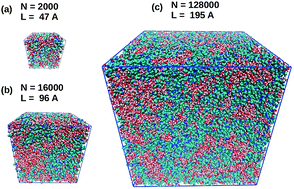Molecular emulsions: from charge order to domain order
Abstract
Aqueous mixtures of small molecules, such as lower n-alkanols for example, are known to be micro-segregated, with domains in the nano-meter range. One consequence of this micro-segregation would be the existence of long range domain–domain oscillatory correlations in the various atom–atom pair correlation functions, and subsequent pre-peaks in the corresponding atom–atom structure factors, in the q-vector range corresponding to nano-sized domains. However, no such pre-peak have ever been observed in the large corpus of radiation scattering data published so far on aqueous mixtures of small n-alkanols. By using large scale simulations of aqueous–1propanol mixtures, it is shown herein that the origin for the absence of scattering pre-peak resides in the exact cancellation of the contributions of the various atom–atom correlation pre-peaks to the total scattered intensity. The mechanism for this cancellation is due to the differences in the long range oscillatory behaviour of the correlations (beyond 1 nm), which are exactly out-of-phase between same species and cross species. This is similar to the charge order observed in ionic melts, but differs from room temperature ionic liquids, where the segregation is between charged and neutral groups, instead of species segregation. The consequences of such cancellation in the experimental scattering data are examined, in relation to the possibility of detecting micro-segregation through such methods. In the particular case of aqueous–1propanol mixtures, it is shown the X-ray scattering leads an exact cancellation, while this cancellation in neutron scattering is seen to depend on the deuteration ratio between solvent and solute.



 Please wait while we load your content...
Please wait while we load your content...